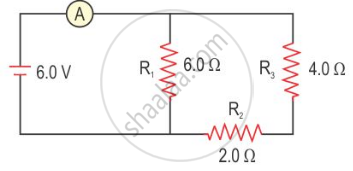Advertisements
Advertisements
प्रश्न
Three resistors of 6.0 Ω, 2.0 Ω and 4.0 Ω are joined to an ammeter A and a cell of emf 6.0 V as shown in the following figure. Calculate :
- the effective resistance of the circuit.
- the reading of ammeter.

उत्तर
From circuit diagram
R3 and R2 are in series
R3 = i.e 4 + 2 = 6 Ω
Now R3 and R1 are in parallel
- Total resistance = `1/"R" = 1/6 + 1/6`
= `2/6` or
R = `6/2 `
= 3 Ω - I = `"V"/"R"`
= `6.0/3.0`
= 2 A
APPEARS IN
संबंधित प्रश्न
In series combination which remains constant?
(a) Voltage
(b) Current
(c) Both current and voltage
(d) Both are variables
(i) Two sets A and B, of three bulbs each, are glowing in two separate rooms. When one of the bulbs in set A is fused, the other two bulbs also cease to glow. But in set B, when one bulb fuses, the other two bulbs continue to glow. Explain why this phenomenon occurs.
(ii) Why do we prefer arrangements of Set B for house circuiting?
Name the material which is the best conductor of electricity.
If five resistances, each of value 0.2 ohm, are connected in series, what will be the resultant resistance?
Calculate the equivalent resistance between P and Q from the following diagram:
Six resistances are connected together as shown in the figure. Calculate the equivalent resistance between points A and B.

Three resistors of 6Ω, 3Ω and 2Ω are connected together so that their total resistance is greater than 6Ω but less than 8Ω Draw a diagram to show this arrangement and calculate its total resistance.
What should be the length of a nickel wire of area of cross-section 3 mm2 used for making a rheostat of 750 ohm? (ρ of nickle = 0.069 Ohm mm2/m)
Two resistors having 2Ω and 3Ω resistance are connected—(i) in series, and (ii) in parallel. Find the equivalent resistance in each case.
